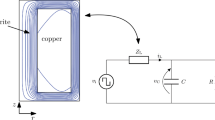Abstract
Linear networks with ideal switches have various applications in power converters, signal processing and control problems, which can be modeled by linear complementarity systems (LCSs). This paper presents new results on the least-element time-stepping method for simulation of linear networks with ideal switches for a class of LCSs. The method is efficient and stable and can be easily implemented. The convergence results and preliminary numerical results show that the least-element time-stepping method is efficient for verifying accuracy of approximate solutions.










Similar content being viewed by others
References
V. Acary, O. Bonnefon, B. Brogliato, Nonsmooth Modeling and Simulation for Switched Circuits, vol. 69 (Springer, Dordrecht, 2010)
V. Acary, O. Bonnefon, B. Brogliato, Time-stepping numerical simulation of switched circuits within the nonsmooth dynamical systems approach. IEEE Trans. Comput.-Aided Des. Integr. Circ. Syst. 29, 1042–1055 (2010)
M.D. Bernardo, C. Budd, A. Champneys, P. Kowalczyk, Piecewise-Smooth Dynamical Systems: Theory and Applications (Springer, New York, 2008)
M.D. Bernardo, F. Garefalo, L. Glielmo, F. Vasca, Switchings, bifurcations, and chaos in DC/DC converters. IEEE Trans. Circuit Syst. I(45), 133–141 (1998)
M.D. Bernardo, F. Vasca, Switchings, bifurcations, and chaos in DC/DC converters. IEEE Trans. Circuit Syst. I(45), 133–141 (1998)
B. Brogliato, A. Daniilidis, C. Lemaréchal, V. Acary, On the equivalence between complementarity systems, projected systems and differential inclusions. Syst. Control Lett. 55, 45–51 (2006)
B. Brogliato, D. Goeleven, Existence, uniqueness of solutions and stability of nonsmooth multivalued Lur’e dynamical systems. J. Convex Anal. 20, 881–900 (2013)
M. Camlibel, Complementarity methods in the analysis of piecewise linear dynamical systems. Ph.D. thesis, Center for Economic Research, Tilburg University, The Netherlands (2001)
M. Camlibel, W. Heemels, J. Schumacher, Consistency of a time-stepping method for a class of piecewise-linear networks. IEEE Trans. Circuit Syst. I(49), 349–357 (2002)
M. Camlibel, W. Heemels, J. Schumacher, On linear passive complementarity systems. Eur. J. Control 8, 220–237 (2002)
M. Camlibel, L. Iannelli, F. Vasca, Passivity and complementarity. Math. Program., Ser. A 145, 531–563 (2014)
M.K. Camlibel, W.P.M.H. Heemels, A. van der Schaft, J. Schumacher, Switched networks and complementarity. IEEE Trans. Circuits Syst. I(50), 1036–1046 (2003)
X. Chen, Z. Wang, Computational error bounds for differential linear variational inequality. IMA J. Numer. Anal. 32, 957–982 (2012)
X. Chen, S. Xiang, Newton iterations in implicit time-stepping method for differential linear complementarity systems. Math. Program. Ser. A 138, 579–606 (2013)
L. Chua, Nonlinear circuits. IEEE Trans. Circuits Syst. I(31), 69–87 (1984)
R. Cottle, J.S. Pang, R. Stone, The Linear Complementarity Problem (Academic Press, Boston, 1992)
R. Frasca, M. Camlibel, I. Goknar, L. Iannelli, F. Vasca, Linear passive networks with ideal switches: consistent initial conditions and state discontinuities. IEEE Trans. Circuit Syst. I(57), 3138–3151 (2010)
L. Han, A. Tiwari, M. Camlibel, J.S. Pang, Convergence of time-stepping schemes for passive and extended linear complementarity systems. SIAM J. Numer. Anal. 47, 3768–3796 (2009)
W. Heemels, B. Brogliato, The complementarity class of hybrid dynamical systems. Eur. J. Control 9, 322–360 (2010)
W.P.M.H. Heemels, M. Camlibel, A. van der Schaft, J. Schumacher, Modelling, well-posedness, and stability of switched electrical networks, in Hybrid Systems: Computation and Control, ed. by O. Maler, A. Pnueli (Springer, Berlin, 2003), pp. 249–266. (chap. LNCS 2623)
W.P.M.H. Heemels, M.K. Camlibel, J.M. Schumacher, B. Brogliato, Observer-based control of linear complementarity systems. Int. J. Robust Nonlinear Contr. 21, 1193–1218 (2011)
W.P.M.H. Heemels, M.K. Camlibel, J. Schumacher, On the dynamic analysis of piecewise linear networks. IEEE Trans. Circuit Syst. I(49), 315–327 (2002)
D. Leenaerts, On linear complementarity systems. IEEE Trans. Circuit Syst. I(46), 1022–1026 (1999)
D. Leenaerts, W. Bokhoven, Piecewise Linear Modeling and Analysis (Kluwer, Deventer, 1998)
Y. Lootsma, A.J. van der Schaft, M. Camlibel, Uniqueness of solutions of relay systems. Automatica 35, 467–478 (1999)
J.S. Pang, Three modeling paradigms in mathematical programming. Math. Program. Ser. B 125, 297–323 (2010)
J.S. Pang, D. Stewart, Differential variational inequalities. Math. Program. Ser. A 113, 345–424 (2008)
J.M. Schumacher, Complementarity systems in optimization. Math. Program. Ser. B 101, 263–295 (2004)
V. Sessa, L. Iannelli, F. Vasca, A complementarity model for closed-loop power converters. IEEE Trans. Power Electron. 29(12), 6821–6835 (2014)
M. Tadeusiewicz, A. Kuczyński, A very fast method for the DC analysis of diode–transistor circuits. Circuits Syst. Signal Process. 32(2), 433–451 (2013)
L. Vandenberghe, B.L.D. Moor, J. Vandewalle, The generalized linear complementarity problem applied to the complete analysis of resistive piecewise-linear circuits. IEEE Trans. Circuit Syst. I(36), 1382–1391 (1989)
A.J. van der Schaft, J.M. Schumacher, The complementarity-slackness class of hybrid systems. Math. Contr. Signals Syst. 9, 266–301 (1996)
A.J. van der Schaft, J.M. Schumacher, Complementarity modeling of hybrid systems. IEEE Trans. Autom. Control 43, 483–490 (1998)
J. van Eijndhoven, Solving the linear complementarity problem in circuit simulation. SIAM J. Control Optim. 24, 1050–1062 (1986)
F. Vasca, L. Iannelli, M.K. Camlibel, R. Frasca, A new perspective for modeling power electronics converters: complementarity framework. IEEE Trans. Power Electron. 24, 456–468 (2009)
X. Yao, L. Wu, W.X. Zheng, C. Wang, Passivity analysis and passification of Markovian jump systems. Circuits Syst. Signal Process. 29(4), 709–725 (2010)
Acknowledgements
The authors would like to thank the anonymous referees for their helpful comments.
Author information
Authors and Affiliations
Corresponding author
Additional information
This work is supported partly by Hong Kong Research Grant Council Grant PolyU153016/16P, National Natural Science Foundation of China (No. 11771454, No. 11626147) and Mathematics and Interdisciplinary Sciences Project, Central South University.
Rights and permissions
About this article
Cite this article
Xiang, S., Chen, X. & Zhou, Y. Least-Element Time-Stepping Methods for Simulation of Linear Networks with Ideal Switches. Circuits Syst Signal Process 38, 1432–1451 (2019). https://doi.org/10.1007/s00034-018-0924-3
Received:
Revised:
Accepted:
Published:
Issue Date:
DOI: https://doi.org/10.1007/s00034-018-0924-3




